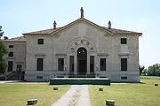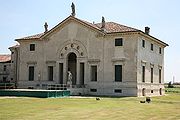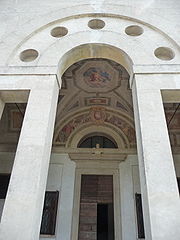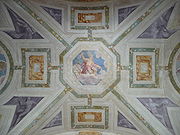
Villa Pojana
Encyclopedia

Villa
A villa was originally an ancient Roman upper-class country house. Since its origins in the Roman villa, the idea and function of a villa have evolved considerably. After the fall of the Roman Republic, villas became small farming compounds, which were increasingly fortified in Late Antiquity,...
in Pojana Maggiore
Pojana Maggiore
Pojana Maggiore is a town and comune in the province of Vicenza, Veneto, Italy. It is the site of Villa Pojana, designed by the Renaissance architect Andrea Palladio. The town has reputation for its agriculture. It is bounded by the other communes of Noventa Vicentina and Montagnana....
, a town of the Province of Vicenza
Province of Vicenza
The Province of Vicenza is a province in the Veneto region of northern Italy. Its capital city is Vicenza.The province has an area of 2,723 km², and a total population of 840,000 . There are 121 comuni in the province...
in the Veneto
Veneto
Veneto is one of the 20 regions of Italy. Its population is about 5 million, ranking 5th in Italy.Veneto had been for more than a millennium an independent state, the Republic of Venice, until it was eventually annexed by Italy in 1866 after brief Austrian and French rule...
region of Italy
Italy
Italy , officially the Italian Republic languages]] under the European Charter for Regional or Minority Languages. In each of these, Italy's official name is as follows:;;;;;;;;), is a unitary parliamentary republic in South-Central Europe. To the north it borders France, Switzerland, Austria and...
. It was designed by the Renaissance architect Andrea Palladio
Andrea Palladio
Andrea Palladio was an architect active in the Republic of Venice. Palladio, influenced by Roman and Greek architecture, primarily by Vitruvius, is widely considered the most influential individual in the history of Western architecture...
. It is conserved as part of a UNESCO
UNESCO
The United Nations Educational, Scientific and Cultural Organization is a specialized agency of the United Nations...
World Heritage Site
World Heritage Site
A UNESCO World Heritage Site is a place that is listed by the UNESCO as of special cultural or physical significance...
, "City of Vicenza
Vicenza
Vicenza , a city in north-eastern Italy, is the capital of the eponymous province in the Veneto region, at the northern base of the Monte Berico, straddling the Bacchiglione...
and the Palladian Villas of the Veneto
Palladian Villas of the Veneto
The City of Vicenza and the Palladian Villas of the Veneto is a World Heritage Site protecting a cluster of works by the architect Andrea Palladio. UNESCO inscribed the site on the World Heritage List in 1994. At first the site was called "Vicenza, City of Palladio" and only buildings in the...
".
History
The Villa Pojana was built in the years 1548-1549 for Bonifacio Pojana, a member of the Pojana family who had been local landowners for centuries. Bonifacio's military background is expressed on the one hand by the severity and austere purity of the architecture and on the other hand by the decorative programme described below.
Architectural details
Palladio's design was inspired by ancient Roman baths, which he had studied during a trip to RomeRome
Rome is the capital of Italy and the country's largest and most populated city and comune, with over 2.7 million residents in . The city is located in the central-western portion of the Italian Peninsula, on the Tiber River within the Lazio region of Italy.Rome's history spans two and a half...
. The main floor is characterized by a large hall with a barrel vault
Barrel vault
A barrel vault, also known as a tunnel vault or a wagon vault, is an architectural element formed by the extrusion of a single curve along a given distance. The curves are typically circular in shape, lending a semi-cylindrical appearance to the total design...
ceiling (see also Villa Pisani in Bagnolo
Villa Pisani (Bagnolo)
thumb|250px|Villa Pisani, the facade facing the river Guà. The towers recall [[Villa Trissino Trettenero]].The Villa Pisani is a patrician villa designed by Andrea Palladio, located in Bagnolo, a hamlet in the comune of Lonigo in the Veneto region of Italy.- History :The Pisani were a rich family...
). At each side of the central hall, secondary rooms extend, each with a different type of vault.
Villa Pojana remains one of the most curious examples of Palladio's architecture even though the Villa was never completed and some of its latter development strayed from Palladio's original design. Of what was built, Palladio demonstrated some of his most creative work, especially in the building's main feature on the façade, a serliana with five circular holes (oculi
Oculus
An Oculus, circular window, or rain-hole is a feature of Classical architecture since the 16th century. They are often denoted by their French name, oeil de boeuf, or "bull's-eye". Such circular or oval windows express the presence of a mezzanine on a building's façade without competing for...
), inspired from ancient Roman models, yet not derivative from any specific source. Other notable elements are the broken pediment, stripped classical features, and statues that depict both military and agricultural deities.
Decorative details


Bernardino India
Bernardino India was an Italian painter of the late Renaissance, born and mainly active in Verona. He is said to have trained with Domenico Riccio. He collaborated with Michele Sanmicheli in the Canossa palace and Pellegrini chapel in San Bernardino of Verona. He collaborated with Felice...
, Anselmo Canera, and Bartolomeo Ridolfi. Canera and India were both painters of the frescos (India of the grotesque
Grotesque
The word grotesque comes from the same Latin root as "Grotto", meaning a small cave or hollow. The original meaning was restricted to an extravagant style of Ancient Roman decorative art rediscovered and then copied in Rome at the end of the 15th century...
s), while Ridolfi was a decorator and sculptor, responsible for stuccos and all fireplaces.
In the atrium
Atrium (architecture)
In modern architecture, an atrium is a large open space, often several stories high and having a glazed roof and/or large windows, often situated within a larger multistory building and often located immediately beyond the main entrance doors...
, elegant stucco
Stucco
Stucco or render is a material made of an aggregate, a binder, and water. Stucco is applied wet and hardens to a very dense solid. It is used as decorative coating for walls and ceilings and as a sculptural and artistic material in architecture...
frames, whose floral designs entwine around trompe l'oeil
Trompe l'oeil
Trompe-l'œil, which can also be spelled without the hyphen in English as trompe l'oeil, is an art technique involving extremely realistic imagery in order to create the optical illusion that the depicted objects appear in three dimensions.-History in painting:Although the phrase has its origin in...
reliefs, enclose monochrome
Monochrome
Monochrome describes paintings, drawings, design, or photographs in one color or shades of one color. A monochromatic object or image has colors in shades of limited colors or hues. Images using only shades of grey are called grayscale or black-and-white...
s of river gods, while here and there appear patches of sky populated with other deities. The bust of Bonifacio Pojana looks down from over the main entrance, and above him are the family's coat of arms and military trophies. Other decorations depict Pompei
Pompei
Pompei is a city and comune in the province of Naples in Campania, southern Italy, famous for its ancient Roman ruins. As of 2010 its population was of 25,671.-History:...
an scenes with the backgrounds and landscapes strewn with picturesque ruins and broken columns, whilst monochromatic figures of warriors stand watch in the trompe l'oeil niches. The frescoed ceiling, with the allegory of Fortuna
Fortuna
Fortuna can mean:*Fortuna, the Roman goddess of luck -Geographical:*19 Fortuna, asteroid*Fortuna, California, town located on the north coast of California*Fortuna, United States Virgin Islands...
, is attributed to Giovanni Battista Zelotti
Giovanni Battista Zelotti
Giovanni Battista Zelotti was an Italian painter of the late Renaissance, active in Venice and her mainland territories.He appears to have been born in Venice, and trained with Antonio Badile and Domenico Riccio, as well as perhaps Titian. Bernasconi claims he trained with his uncle Paolo Farinati...
.
The most significant fresco can be found in the central hall: called the Emperors' Salon it shows a family from classical times, dressed in tunics and togas. They kneel in front of an altar whilst the pater familias
Pater familias
The pater familias, also written as paterfamilias was the head of a Roman family. The term is Latin for "father of the family" or the "owner of the family estate". The form is irregular and archaic in Latin, preserving the old genitive ending in -as...
extinguishes the torch of war at the feet of the statue of Peace which stands on the altar. It is a clear allusion to the peace painfully achieved in the sixteenth century after the War of the League of Cambrai
War of the League of Cambrai
The War of the League of Cambrai, sometimes known as the War of the Holy League and by several other names, was a major conflict in the Italian Wars...
which allowed Venetians to enjoy the delights of the terra firma
Terra firma
Terra firma is a Latin phrase meaning "solid earth" . The phrase refers to the dry land mass on the earth's surface and is used to differentiate from the sea or air.Terra Firma may also refer to:...
.


